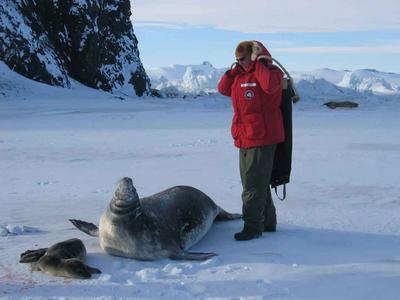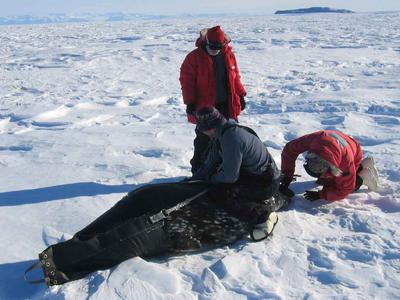
|
|
17 October, 2003
We awoke to a bluebird morning-clear blue skies with Mt. Erebus
towering over the eastern horizon. My first night spent sleeping in
a converted refrigeration box (these sleeping huts began their lives
as semi-truck refrigeration units) went well. I had a comfortable
and toasty bed. We slept with the heat turned down low and the door
slightly ajar-otherwise it would be way too hot. It's about -15C
outside-and almost 22C inside our kitchen hut. Life is good.
It was finally time to learn the fine art of seal tagging. After
breakfast we set out to meet the neighbors-there are two groups of
seals within walking distance of camp. We gathered up our tools; a
daypack with seal tags, sets of tagging pliers and hole punches,
handheld computers, and a notebook for recording a hard copy of our
tagging data. It's also a good idea to wear gloves that you don't
really value too highly, since they get covered with the essence of
seal. In addition we take a seal bag-a conical piece of heavy fabric
about a meter long with 2 looped stout ropes affixed to the sides and
breathing holes at the narrow, or nose, end. While baby seals are
easy to tag without much physical effort, tagging adult seals
requires a more aggressive technique.
While Kelly, Mark, Brent, and I watched, Gillian and Darren showed
how to place the tags in the special tagging pliers and went over
some of the more common pitfalls involved in tagging. It is
important to have the two sides of the tags properly aligned in the
pliers so the post that holds the two sides together doesn't bend or
break. Tags are placed in both rear flippers, in the web of skin
just in from the 'little toe' area. In baby seals the web is thin
enough to allow you to place the tag using only the pliers. In
adults, the web is so thick that you must first punch a hole using a
leather punch and then place the tag using the pliers.
Once tags are firmly affixed to the flippers, it's time to record the
important data. In the field notebooks we record whether the animal
tagged was an adult or pup; in addition, we write whether it was male
or female. We also note whether it has any relatives-in the case of a
female that would be its pup. For example, an adult female with one
pup would be listed as AF1. We also write down its tag number,
usually a 4-digit number followed by the letters 'AA'. The tags are
yellow (noted as A, for amarillo-yellow in Spanish). By writing 'AA'
we know that there are 2 tags with that number-one in each flipper.
We mark down the location and whether it is a new tagging or
re-tagging-seals with missing or broken tags must be re-tagged. Once
all this is done, we enter the information in our handheld computers.
This data is downloaded each evening into a laptop computer.
This might sound relatively straightforward, but it all gets somewhat
more interesting when you add the following factors to the equation:
it's cold, the wind is probably howling, you're standing on a
slippery surface, there's open ice cracks in the vicinity (that's how
those seals got there), and the adult seals do not sit idly by while
they are handled.
Tagging the pups is relatively straightforward. One person uses a
bamboo pole with a red flag at its end to distract the mother, kind
of like an Antarctic version of a matador. By waving the flag in the
mother's face, you can get her to move away from her baby. While she
is busily barking in the direction of the flagger, the tagger steps
in, holds the wriggling baby seal as tightly as possible, and affixes
tags to each rear flipper. The tags have sharp rubber points to go
through the flipper, and these are snipped off after they are applied
so they do not irritate the seal. It all might sound simple, but it
makes you wish you had at least one extra arm to hold down the baby.
Tagging adult seals is a bit trickier. This is where it really gets
exciting and the seal bag comes into use. Darren and Gillian
demonstrated proper bagging technique. You grab the seal bag firmly
by its side ropes, hold it behind your back, and just below your head
and slowly approach the seal. When you are alongside the seal you
whip the bag over your head towards the seal and, hopefully, end up
with it over the seal's head. Then the dance begins, as the seal
tries to back out of the bag and you straddle it trying to keep the
bag over its head until it calms down and lies still. If all goes
well, the seal will soon tire of this game and lie calmly on the ice
while you punch a hole in each rear flipper and apply the tags.
Darren and Gillian made it look relatively easy-but it was obvious
that it was much harder than it looked.
We returned to our camp for snacks and hot beverages, and set off on
the snow mobiles to look for seal pups and apply our newly learned
tagging, bagging, and recording skills at a colony near Tent Island,
about 15 minutes away. We split into two groups, and worked our way
along one side of the island. Our group encountered 2 female/pup
pairs-both females were already tagged from previous years, so we
only needed to distract them while we tagged their babies. I was
able to try my hand at the seal bag dance with an adult male that had
broken tags. When tags are broken, they need to be removed and
replaced with new ones. Gillian attempted to distract him with the
red flag, while I stood with the bag, waiting for just the right
moment to get it over his head. He was positioned next to a large
ice crack and used this to his advantage, crossing back and forth
after each unsuccessful bagging attempt. In the end it was 'Seal 1,
Susy 0' as he reached a diving hole and disappeared under the ice.
Bagging the seals definitely takes practice. I've never danced with
a 1000 lb animal before-it just takes time to get the steps right.
Over the next few weeks I am sure I'll have ample opportunities to
practice.
Why are we dancing with seals? A primary focus of this project is to
study the demographics of the Weddell Seal population. To do this,
you need to have a method for tracking individual seals. Tagging
animals and tracking them over a long period of time will give you
information that can help you determine longevity and survival as
well as the number of pups born each year and the ratio of males to
females in the population. Scientists have been studying Erebus Bay's
Weddell Seal population for over 34 years. During this period, over
15,000 animals have been tagged. This year's project will add to
that database and provide information that will allow further
analysis of this population.
Daily Haiku:
Weddell Seal tagging
Dance with a thousand pound seal
Watch out for their heads

Darren selects a tag

Tagging a pup

Approaching the seal

Over the head

Darren holds the seal while Gillian places tags in each flipper

The view from camp--Mount Erebus, the southernmost active volcano

A map of our study area

Darren demonstrates the fine art of seal bagging
Contact the TEA in the field at
.
If you cannot connect through your browser, copy the
TEA's e-mail address in the "To:" line of
your favorite e-mail package.
|
